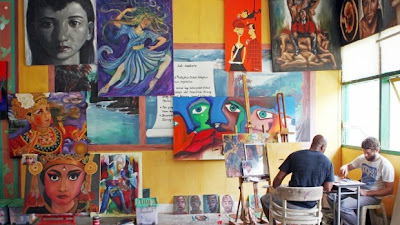 |
| Myuran Sukumaran (left) and Ben Quilty in Kerobokan prison's art workshop |
Farrow didn’t know Quilty personally, but had seen his Archibald Prize-winning portrait of Margaret Olley and thought she’d try her luck. So she explained how Sukumaran had taken up painting at Indonesia’s Kerobokan Prison, and how it was the “challenge of a lifetime”. He was going to enter a portrait of his lawyer, Julian McMahon, into the Archibald, even though he wouldn’t be eligible because he hadn’t lived in Australia during the previous 12 months. He had, of course, been locked up in Kerobokan since his arrest in 2005. Sukumaran had found “peace and salvation” in art, Fallow said, but he needed some “constructive advice”. “Could that be you or someone you know?”
A few days later, Quilty sent a message back: “I will help.”
Were it not for the Bali Nine, Quilty may never have travelled to Bali. Based in the NSW southern highlands, his adventures abroad tend to follow a certain pattern. In 2003, he travelled to Paris after winning the Brett Whiteley Travelling Art Scholarship. In 2007, he spent four months in Spain on an Australia Council residency. Four years later he found himself working in Afghanistan, an official war artist for the Australian War Memorial. And earlier this year he joined Richard Flanagan in Lebanon, Greece and Serbia, documenting the exodus of Syrian refugees. But Bali? It wasn’t his thing. “It’s not for me to go to a Third World country and get massages,” Quilty says. “Never has been.”
That Facebook message, though, had made Quilty curious. Like so many others in Australia, he had followed the case of the Bali Nine as it played out in front of the cameras. The fate of the nine young Australians had seemed inevitable from the moment of their arrest in April 2005, trying to smuggle heroin out of Indonesia. Denpansar judges handed down their sentences less than a year later. While seven of the nine were ordered to spend the rest of their lives behind bars, a harsher sentence awaited the pair seen to have leadership roles: death by firing squad for Sukumaran, the “enforcer”, along with his friend, the “godfather” Andrew Chan.
For Quilty, there was something else that caught his attention. It’s common for artists who have achieved success to be pestered for advice, and he usually recommends a combination of hard work and art school. In this instance, though, there were encouraging signs. Sukumaran was also especially hungry to learn. He was interested in “thick paint”, and this resonated with Quilty, himself an impasto specialist.
“That’s why I engaged,” he says. “The questions he asked very clearly showed that he’d made some progress and that he’d tried, and I thought it was just so remarkable that someone in that circumstance was trying. It was also against the notion that I had of him. I’d only heard the press of him being this evil monster, the enforcer. So I just decided to go there and meet him.”
More than 18 months have now passed since Sukumaran’s execution, and Quilty still stirs with passion and anger about the loss of his friend. As he looks back on those transformative years, recalling all the highs and the terrible lows, there’s also a distinct sense of admiration for Sukumaran’s achievements and character — especially now, on the eve of a new exhibition in Sydney dedicated to the work of a man who entered prison as a criminal and left it as an artist. “It’s a refuge,” Quilty says. “For me, that’s what art is.”
➤ Click here to read the full article
Source: The Australian, Ashley Wilson, December 17, 2016
⚑ | Report an error, an omission; suggest a story or a new angle to an existing story; submit a piece; recommend a resource; contact the webmaster, contact us: deathpenaltynews@gmail.com.
Opposed to Capital Punishment? Help us keep this blog up and running! DONATE!


0 nhận xét:
Post a Comment